Looking for birds with bold colors? You’re in the right place. These Black and White Birds with redheads are a real treat to watch. Some have a bird red head black and white body, while others show off a bright neck or a red patch on the crown. These birds live in forests, parks, and even your backyard.
From tiny songbirds to medium-sized woodpeckers, each has something special. You might spot a black and white bird with red spot on head or a red head black and white body bird pecking at tree bark. Curious about the black and white bird with red head meaning? In many cultures, red-headed birds are seen as signs of energy and passion. Some even show up as a black and white bird with red neck. These striking birds are not only beautiful—they also play key roles in nature. Get ready to meet 17 amazing Black and White Birds!
Top 17 Black and White Birds with Redheads
Top 17 Black and White Birds with Redheads are some of the most eye-catching birds in the wild. Their bold colors stand out in forests, gardens, and parks. These Black and White Birds often have bright red heads or necks.
Some have a full red crown, while others show just a red patch. You might see a black and white bird with red spot on head or even a red head black and white body bird flying by. These Black and White Birds often nest in tree cavities or shrubs.
Each bird has its own meaning and charm. A black and white bird with red head meaning often connects to strength or luck. Whether it’s a bird red head black and white body or a black and white bird with red neck, these birds truly amaze. Bird lovers enjoy spotting these stunning Black and White Birds across the Americas.
Bird 1: Red-bellied Woodpecker
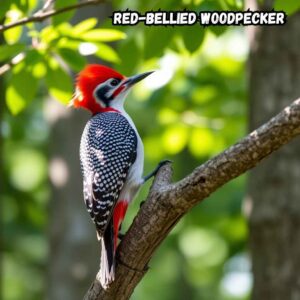
- Scientific name: Melanerpes carolinus
- Lifespan: 12 years
- Wingspan: 16 inches
- Native to: Eastern United States
- Size: 23.5 to 26.7 cm
- Food or Diet: Insects, fruits, spiders, beetles etc
Red-bellied Woodpecker is a medium-sized bird with a striking red head and nape. Its body shows a mix of black and white zebra patterns. Despite its name, the red belly is often faint and hard to spot.
This bird is native to the Eastern United States. It lives in deciduous forests, woodlands, and even suburban areas. You can often find it clinging to tree trunks or flying between branches, making drumming sounds with its strong beak.
Red-bellied Woodpeckers eat insects, fruits, seeds, and tree sap. Their long, sticky tongues help them catch ants, beetles, and caterpillars from deep bark crevices. They also visit feeders for peanuts and suet.
Their nests are built in tree cavities. During the breeding season, both males and females help raise the chicks. These woodpeckers are known for their loud calls and territorial behavior, making them easy to hear even before you see them.
Read More: 10 Bird That Sounds Like an Owl But Isn’t
Bird 2: Red Crested Cardinal

- Scientific name: Paroaria coronata
- Lifespan: 3–6 years around
- Wingspan: 25 to 31cm
- Native to: South America
- Size: 7.5inch (19cm)
- Food or Diet: Seeds, insects, and fruits
Red Crested Cardinal is a striking bird known for its bright red head and bold look. It has a black and white body, which contrasts perfectly with its red crest. People often spot it in parks and gardens.
This bird is native to South America, mainly found in Argentina, Paraguay, and Brazil. It’s also seen in Hawaii, where it was introduced. The Red Crested Cardinal loves open woodlands, suburban areas, and gardens near water.
It builds cup-shaped nests in trees or shrubs. Both parents care for the chicks. They feed on seeds, fruits, insects, and sometimes buds. Their song is soft and sweet, often heard in the morning.
Medium in size, the Red Crested Cardinal has a lifespan of around 6 years. It’s part of the tanager family. Its beauty and calm nature make it a favorite among birdwatchers and nature lovers across the Americas.
Bird 3: Red-headed Woodpecker
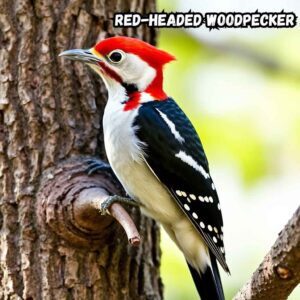
- Scientific name: Melanerpes erythrocephalus
- Lifespan: 9 years
- Wingspan: 16 inches
- Native to: North America
- Size: 7-10inch (17 to 25cm)
- Food or Diet: Insects, fruits, nuts, berries, etc
Red-headed Woodpecker is a striking bird known for its bright red head and bold colors. It has a black back, white wings, and a white belly. This bird is easy to spot in woodlands and open forest areas.
It lives in parts of North America, including the Eastern United States and parts of Canada. The Red-headed Woodpecker often nests in tree cavities. It builds its home high up in dead trees or poles, using cup-shaped nests.
This bird eats a mix of insects, seeds, berries, and fruits. It’s also known to catch flying insects in mid-air. The Red-headed Woodpecker stores food like nuts in tree bark for later use.
Its call is loud and sharp, and it makes drumming sounds on trees. The Red-headed Woodpecker is also very territorial. You can often spot it flying with strong, steady wingbeats across open woodland spaces.
Bird 4: Pine Grosbeak

- Scientific name: Pinicola enucleator
- Lifespan: 8–10 years
- Wingspan: 12–14 inches
- Native to: North America
- Size: 20 to 25cm
- Food or Diet: Berries, seeds, buds, berries
Pine Grosbeak is a large, plump finch found in cold forests. Males have rosy-red heads and chests, while females are yellow-orange. They have black and white wings that stand out against snowy backgrounds. These birds move slowly and calmly.
They live in coniferous forests, especially in Canada, Alaska, and parts of the northern U.S. You can also spot them in montane forests and near forest edges. During winter, they sometimes visit gardens and suburban areas in search of food.
Their diet includes berries, seeds, and buds, especially in colder months. In summer, they also eat insects, spiders, and caterpillars. You may spot them foraging quietly in trees or hopping on the ground for fallen food.
Pine Grosbeaks build cup-shaped nests high in evergreens. They lay eggs in early spring. Known for their sweet, whistling melody and tune, these birds are peaceful and easy to approach, making them a favorite among birdwatchers.
Bird: 5: Hairy Woodpecker

- Scientific name: Leuconotopicus villosus
- Lifespan: 15 years
- Wingspan: 13–16 inches (33 to 41cm)
- Native to: North America
- Size: 18 to 26cm
- Food or Diet: Insects, seeds, ants, beetles, tree sap etc
Hairy Woodpecker is a medium-sized bird with a bold black and white body. It has a strong, downward-pointing beak and a red patch on the head. You’ll often hear its drumming sounds echoing through wooded areas and forests.
It lives in coniferous forests, deciduous forests, and even in heavily wooded parks. You can find it across North America, from Alaska to Florida. The Hairy Woodpecker also nests in tree cavities and lays eggs during the breeding season.
This bird feeds on insects, ants, beetles, and tree sap. It also eats seeds, fruits, and spiders. Foraging on tree trunks, the Hairy Woodpecker uses its sharp bill to dig into bark and find food.
Its black and white plumage with a red head black and white body makes it easy to spot. Whether in the wild or near gardens, this woodpecker stands out with its territorial behavior and loud, sharp calls.
Bird 6: Red-Breasted Sapsucker
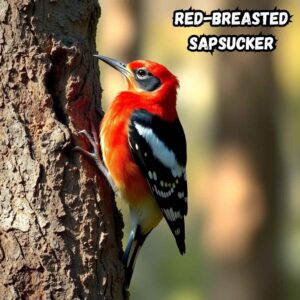
- Scientific name: Sphyrapicus ruber
- Lifespan: 5 years
- Wingspan: 37 to 40cm
- Native to: North America
- Size: 20 to 22cm
- Food or Diet: Tree sap, insects
The Red-Breasted Sapsucker is a striking bird with a bright red head and chest. Its black and white wings add bold contrast. This bird often catches your eye as it moves through forests, especially in the western parts of North America.
It’s known for drilling neat rows of holes in trees. The sap that leaks out attracts insects, which the sapsucker eats. You might also see hummingbirds sipping from the same spots. This bird helps feed others without even trying.
Red-Breasted Sapsuckers prefer forests, especially those with pine and cedar trees. They nest in tree cavities and often return to the same spot. You’ll hear their rhythmic drumming on tree trunks, which they use to mark territory and find mates.
They eat insects, sap, and berries. In colder seasons, they rely more on tree sap. This colorful bird may be small, but it plays a big role in the forest ecosystem.
Bird 7: Scarlet Myzomela
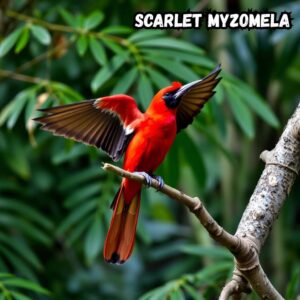
- Scientific name: Myzomela sanguinolenta
- Lifespan: 9 years
- Wingspan: 15 cm
- Native to: Australia, Papua
- Size: 9 to 11cm
- Food or Diet: Nectar, insects, flowers, etc
Scarlet Myzomela is a small, bright bird known for its deep red color. It has a black back and wings, giving it a bold look. This tiny bird is full of energy and quick in its movements through trees.
You’ll mostly find Scarlet Myzomela in Australia and nearby islands. It lives in mangroves, woodlands, and gardens. It builds cup-shaped nests and often hides them in shrubs. These birds are very territorial during the breeding season.
Their diet mainly includes nectar, but they also eat insects and spiders. The Scarlet Myzomela uses its long, curved beak to reach deep into flowers. It helps pollinate plants while feeding, making it important for the ecosystem.
Though small, Scarlet Myzomela is loud and sings sweet tunes. Its melody and tune fill the air in the morning. People love spotting this red jewel among green leaves, flashing like a tiny flame in the forest.
Bird 8: Red Siskin

- Scientific name: Spinus cucullatus
- Lifespan: 5 years
- Wingspan: 8 inches
- Native to: Venezuela, Colombia
- Size: 10 to 11cm
- Food or Diet: Seeds, insects and fruits
Red Siskin is a small songbird known for its fiery red plumage and cheerful song. Males have bright red heads, chests, and backs, with black wings and tails. Females are duller but still charming with subtle red tones.
These birds are mostly found in northern South America, especially in Venezuela, Colombia, and Guyana. They prefer open woodlands, forest edges, and shrublands. Red Siskins also visit gardens and landscaped areas in search of food and shelter.
Their diet mainly includes seeds, buds, and small insects. In the wild, they often feed on grass seeds and soft plant parts. Red Siskins are active foragers and hop quickly between branches and low shrubs.
Sadly, Red Siskins are an endangered species due to habitat loss and illegal trapping. Conservation efforts now focus on protecting wild populations and breeding them in captivity to help restore their numbers across their natural habitats.
Bird 9: Flame-colored Tanager
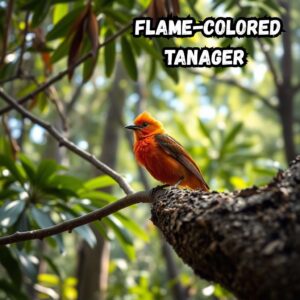
- Scientific name: Piranga bidentata
- Lifespan: 3 years
- Wingspan: 11 inches
- Native to: Mexico, Panama
- Size: 7inch (18-19cm)
- Food or Diet: Insects, berries, fruits etc
Flame-colored Tanager is a stunning bird with fiery red-orange feathers. Males are brighter, while females have more yellow tones. Their black wings and tail create a bold contrast. These birds often stand out against the green leaves of mountain forests.
They are commonly found in Mexico, Guatemala, and parts of Central America. You’ll see them in montane forests, especially near oaks and pines. They like wooded areas and often appear in small flocks or pairs, staying active during the day.
Flame-colored Tanagers feed on insects, berries, and small fruits. They hop between branches searching for food. Their strong beaks help crack seeds and catch caterpillars or beetles. They also enjoy nectar and sometimes follow mixed-species flocks to forage.
Their nests are cup-shaped, hidden in trees. These birds sing soft but musical notes during the breeding season. They show strong territorial behavior, especially during nesting. Bright, bold, and active, they’re a joy to observe.
Bird 10: Red Capped Cardinals
- Scientific name: Paroaria gularis
- Lifespan: 8 years
- Wingspan: 10 inches
- Native to: South America
- Size: 6.5inch (16.5cm)
- Food or Diet: Insects, seeds, berries, rice etc
Red Capped Cardinals are striking birds with bright red heads and bold black and white bodies. Their vivid colors stand out near water or shaded trees. These birds often perch on low branches, making them easy to spot and admire.
They live mainly in South America, especially near the Amazon Basin, Brazil, and Venezuela. You can find them in mangroves, river lowlands, and even city parks. Their calm nature makes them a favorite among birdwatchers and nature lovers.
Red Capped Cardinals build cup-shaped nests in shrubs or low trees. Both parents help feed the chicks. They usually eat seeds, fruits, and small insects like beetles and caterpillars. Their gentle calls add charm to quiet mornings.
Though not very large, they’re full of personality. Their red caps shine brightly in the sun. Watching these birds can feel like a peaceful moment in nature, especially near water or wooded trails.
Bird 11: Red Faced Warbler
- Scientific name: Cardellina rubrifrons
- Lifespan: 5–6 years
- Wingspan: 7 inches
- Native to: Mexico, Arizona
- Size: 5inch (14cm)
- Food or Diet: Insects, spiders, flies, aphids etc
Red Faced Warbler is a small songbird with a bright red face and throat. It has a black cap, white belly, and gray wings. This bird looks striking among the green trees and is easy to recognize.
They mostly live in coniferous forests and montane forests. You’ll often find them in parts of Arizona, New Mexico, and Mexico. These birds enjoy cool, high places with tall trees and thick shade.
During breeding season, the Red Faced Warbler lays around 3 to 5 eggs. They build cup-shaped nests hidden under shrubs or near forest floors. Both parents take turns feeding the chicks after they hatch.
They eat small insects, spiders, and caterpillars. Their quick movements and sweet songs make them a joy to watch. These warblers are a lovely part of the bird world and brighten up any forest with their colorful charm.
Bird 12: Scarlet Tanager
- Scientific name: Piranga olivacea
- Lifespan: 10 years
- Wingspan: 9 to11 inches
- Native to: North America
- Size: 6.3 to 6.7inch (16 to 17cm)
- Food or Diet: Insects, fruits, wasps, bees etc
Scarlet Tanager is a stunning bird with bright red feathers and jet-black wings. Males have vivid red bodies, while females are olive-yellow. These small songbirds are easy to spot during spring and summer in leafy forests across the Eastern United States.
They mostly live in deciduous forests, especially those with tall trees. You can also find them in heavily wooded parks, gardens, and even suburban areas. During migration, they fly all the way to South America, including Brazil, Peru, and Bolivia.
A female Scarlet Tanager lays 3 to 5 eggs per nesting season. Their nests are usually cup-shaped and placed high in trees. They raise their young in quiet, safe spots away from predators and noise.
These birds eat insects, berries, and seeds, and they love caterpillars and spiders too. Their sweet melody and tune fill the forests. Known for their shy nature, they’re a true hidden gem in the treetops.
Bird: 13 Crimson-breasted Woodpecker
- Scientific name: Campephilus melanoleucos
- Lifespan: 5–7 years
- Wingspan: 10–12 inches
- Native to: Asia, Himalayas
- Size: 19cm
- Food or Diet: Insects, larvae, beetles, butterflies
Crimson-breasted Woodpecker is a small but striking bird. It has a red breast, black and white plumage, and a bold look. Its crown black patch stands out. This bird often shows strong bills and white wing bars on black backs.
It lives mostly in forests, woodlands, and mature secondary forests. You can find it in parts of the Eastern Himalayas, India, Nepal, Bhutan, and Bangladesh. It prefers trees with soft bark for nesting and feeding.
The Crimson-breasted Woodpecker usually lays 3 to 5 eggs in a season. It nests inside tree cavities where both parents care for the chicks. Their cup-shaped nests are safe from predators and well hidden in thick trees.
This woodpecker feeds on insects, ants, and larvae found under bark. Sometimes it eats fruits or seeds. It uses strong pecking to make drumming sounds, a common sign of its territorial behavior in the wild.
Bird 14: Pileated Woodpecker
- Scientific name: Dryocopus pileatus
- Lifespan: 12 years
- Wingspan: 30 inches
- Native to: North America
- Size: 16 to 20inch
- Food or Diet: Insects, ants, fruits, berries, ants, etc
Pileated Woodpecker is one of the largest woodpeckers in North America. It has a bold black and white body with a bright red crest on its head. This bird is known for its loud call and strong drumming sounds.
It lives in forests, especially in deciduous and coniferous woodlands. You can spot it in the Eastern United States, Canada, and parts of the Pacific Northwest. It often nests in tree cavities and stays close to wooded areas.
The Pileated Woodpecker lays about 3 to 5 eggs each breeding season. Both parents take turns incubating the eggs. They raise their chicks in deep, cup-shaped nests carved into dead trees or logs.
These birds mostly eat ants, beetles, caterpillars, and fruits. They use their strong beaks to drill into trees for food. Their presence helps control insect pests and supports forest health, making them an important part of the ecosystem.
Bird 15: Downy Woodpecker
- Scientific name: Dryobates pubescens
- Lifespan: 5 years
- Wingspan: 11 inches
- Native to: North America
- Size: 5 to 6inch (14 to 17cm)
- Food or Diet: Insects, seeds, millet, peanuts, etc
Downy Woodpecker is one of the smallest woodpeckers in North America. It has a black and white body with a small red patch on the male’s head. This bird is easy to spot in backyards, gardens, and wooded parks.
They live in the United States, Canada, and even parts of Alaska. You’ll often find them in forests, orchards, and suburban areas. Downy Woodpeckers also visit feeders and like wooded places with lots of trees and shrubs.
The female lays about 3 to 8 eggs at a time. They build their nests in tree cavities during spring. Both parents take turns keeping the eggs warm and feeding the chicks after hatching.
They eat insects like ants and beetles. They also enjoy seeds, berries, and tree sap. These birds help control pests and bring life to quiet forests with their soft drumming sounds and cheerful behavior.
Bird 16: Ladder-backed Woodpecker
- Scientific name: Dryobates scalaris
- Lifespan: 4–5 years
- Wingspan: 13 inches
- Native to: Mexico, USA
- Size: 6.3 to 7,1inch (16 to 18cm)
- Food or Diet: Insects, larvae, ants, etc
Ladder-backed Woodpecker is a small, active bird found mostly in dry, open areas. You can often see it in deserts, shrublands, and Black and White Birds habitats like New Mexico, Arizona, and parts of Mexico.
This bird has a black and white barred back, with a red crown in males. It belongs to the group of Black and White Birds known for their drumming sounds and strong beaks used to peck at tree bark.
The female Ladder-backed Woodpecker usually lays 3 to 7 eggs in a tree cavity. Like many Black and White Birds, it builds cup-shaped nests and raises its chicks in wooded or semi-open areas.
Black and White Birds like this one eat insects, ants, and beetles. The Ladder-backed Woodpecker also enjoys berries and seeds. Its sharp call and bold patterns make it easy to spot in the wild.
Bird 17: White-winged Tanager
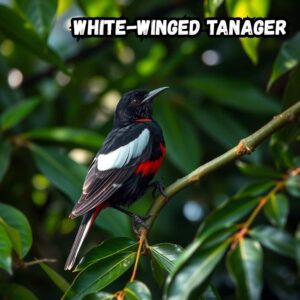
- Scientific name: Piranga leucoptera
- Lifespan: 5–6 years
- Wingspan: 9 inches
- Native to: Central America
- Size: 13cm (5.1inch)
- Food or Diet: Fruits, insects, berries, seeds, etc
White-winged Tanager is a colorful bird known for its black and white wings and bright red body. It belongs to the cardinal family and is easy to spot. These Black and White Birds are small but full of life and color.
They are mostly found in Central America, Mexico, and parts of South America. You can also see them in cloud forests and montane forests. These Black and White Birds live in places like Guatemala, Honduras, and down to Bolivia and Peru.
During breeding season, the female lays around 2 to 3 eggs in cup-shaped nests. They often nest in tree cavities or high branches for safety. Both parents help raise the chicks until they are ready to fly.
The diet of the White-winged Tanager includes insects, fruits, and seeds. They forage in pairs or small groups. Their calls are soft but sweet, often heard in the morning light.
FAQ’S
What makes these birds so noticeable?
Their colors stand out sharply in nature. Black and White Birds often have bright red heads, making them easy to recognize from a distance.
Where do these birds usually live?
They are found in forests, parks, and gardens. Many Black and White Birds prefer tree cavities or forest floor nests for breeding.
Do they all have red heads?
Most have red crests or patches. Some Black and White Birds show a red neck or crown that adds to their unique look.
What do they eat?
Their diet includes insects, berries, seeds, and tree sap. Black and White Birds also enjoy caterpillars, ants, and even fruits from shrubs.
Are they seen all year?
Some species migrate during cold seasons. Many Black and White Birds stay in warm places like Florida, Mexico, or the Amazon Basin year-round.
Conclusion
Black and White Birds are some of the most beautiful birds you can spot. Their mix of black, white, and red is bold and stunning. You might see a bird red head black and white body sitting on a branch. Others may show a black and white bird with red neck or just a black and white bird with red spot on head. No matter the type, these birds always catch your eye. They live in forests, parks, and even suburban gardens.
Many of these Black and White Birds have special meanings in different cultures. The black and white bird with red head meaning often links to strength or bold energy. Whether small songbirds or medium-sized woodpeckers, they each have a role in nature. You may also see a red head black and white body bird foraging for food. From their striking looks to their smart behavior, these birds are truly amazing to learn about.

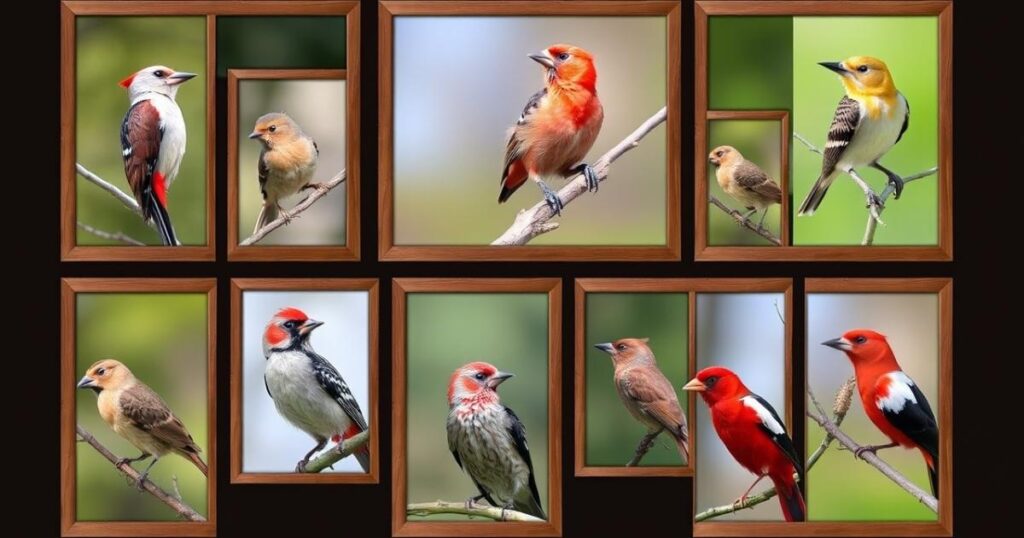
1 thought on “Top 17 Black and White Birds with Redheads”